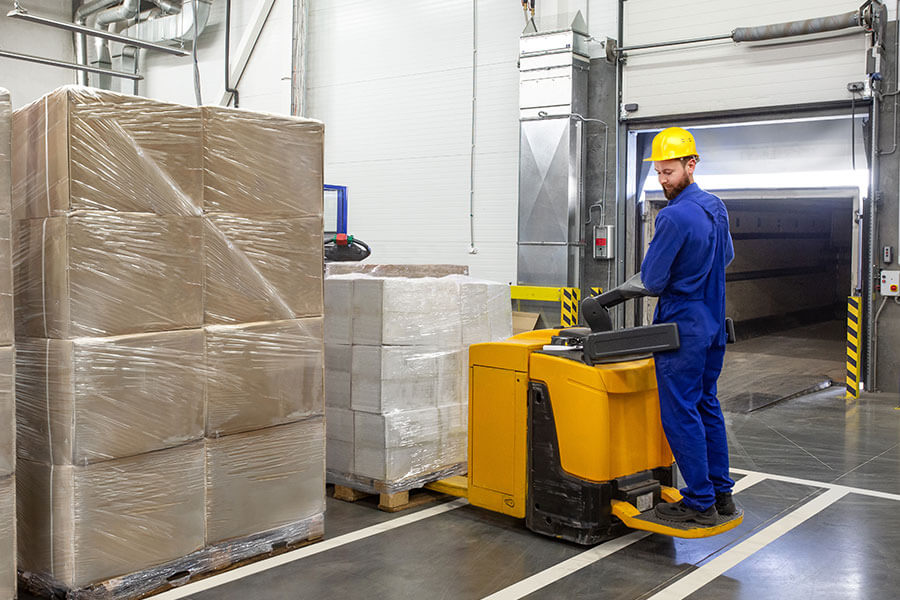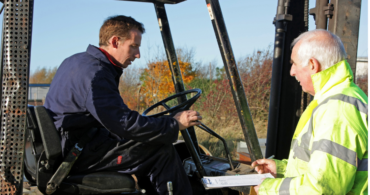There’s more to deciding between a stand up forklift and a sit down forklift than the obvious. Making the wrong choice can significantly impact the efficiency and effectiveness of your warehouse operation.
If you were to ask a random person on the street to draw a forklift, they would likely doodle someone behind the wheel of a sit down lift. However, as every warehouse manager and forklift operator knows, there are many different types of forklifts. While every type accomplishes the task of moving a heavy load from point A to point B, they do so in different ways for very different operational needs.
While one difference between a stand up forklift and a sit down forklift is very obvious, other subtler factors influence the choice of one over the other.
What is a sitting forklift?
A sit down forklift is the most commonly used forklift (there’s a reason most people picture one when they think of a lift truck). There are two general types of sitting forklifts: the 3-wheel and 4-wheel models. On average, the 4-wheel models can handle heavier loads and tend to be more rugged because they have an articulated rear steer axle, which helps the driver navigate rough terrain and uneven warehouse flooring). The 3-wheel models have more maneuverability and are better at navigating smaller spaces. However, when carrying a heavy load, a 3-wheel sit down lift can be a little unsteady during turns.
The forklift sit down option tends to be more comfortable for an operator, especially when they need to drive a forklift for extended periods. However, when an operator needs to get out of the forklift frequently, a sitting forklift can actually be a hindrance.
What is a stand up forklift?
Because its cab has no seat, a stand up forklift has a much smaller profile than a sit down forklift. This makes standing lifts popular for small warehouses because they save space. Their smaller profile also makes stand up forklifts better suited for warehouses with narrow aisles. They are also more maneuverable than a 3- or 4-wheel sit down lift.
Stand up vs sit down forklift
Driving
It doesn’t take long for most operators to become comfortable driving a sitting forklift because it uses a traditional steering wheel, similar to a typical automobile. The main difference, of course, is the hydraulic lever used to operate the lift.
A stand up forklift operator uses a single joystick to both steer the lift and operate the forks. This system can take longer for the driver to feel completely confident controlling when learning to drive a standing lift truck.
Dismounting
A sit down forklift is generally more comfortable for the operator as long as that person remains seated for extended periods. However, if the job requires someone to frequently leave the lift truck, such as for loading and unloading small amounts of different products, then a stand up forklift is usually more comfortable to operate.
This comfort reversal occurs due to a couple of reasons. Primarily, the repetitive stress of standing and sitting can be stressful to a person’s back, knees and legs. Another issue occurs due to an Occupational Safety and Health Administration (OSHA) rule that states an operator of a sitting forklift is required to wear a seatbelt, while a stand up forklift operator is not. This rule helps protect a driver should an accident occur. However, while buckling and unbuckling a seatbelt a couple times a day is no big deal, doing it several times an hour is one of those small irritations that can become a big hassle. Worse still, a driver may choose to ignore the rule, placing them in greater danger should an accident occur. Conversely, someone driving a stand up forklift simply needs to step in and out of the vehicle.
Aisle navigation
As previously mentioned, the smaller footprint of a stand up forklift means it’s ideally suited to navigate narrow aisles. This is especially true for dead-end aisles that require the lift truck operator to reverse. In a sit down forklift, the driver needs to twist their torso to look over their shoulder to reverse. It’s not impossible, but reversing is much easier in a stand up forklift because the driver just needs to turn their head or change their position slightly, and nothing blocks their line of sight.
Operating environment
If the job site is an area that experiences a lot of spills or the terrain is uneven, it’s safer to use a 4-wheel sit down forklift. However, for areas with clean and level worksurfaces, other factors (aisle size, job description, etc.) should guide the decision.
Counterbalanced 3-point suspension system
One element that a stand up forklift and a sit down forklift share is that both lift truck types utilize a 3-point suspension system to distribute the vehicle’s weight. The 3-points of this suspension system create what’s known as the stability triangle.
When a forklift picks up a load, its center of gravity moves from the middle of the vehicle toward the front. However, as long as that center of gravity stays in the stability triangle, the forklift remains balanced.
Counterbalancing also helps keep these vehicles stable. A lift truck is designed with a great deal of weight located in the rear, much or all of it due to the heavy battery that powers the vehicle. In fact, most forklifts weigh nearly twice their rated carrying capacity. This weight is necessary to keep the center of gravity within the stability triangle.
We hope your stand up forklift vs sit down decision is now much easier. Should you ever have any issues with your fleet of lift trucks, please reach out to Texas Motive Solutions. When it comes to batteries, we’re your forklift repair experts. Please call us at (888) 316-2459 or fill out a form to learn about our services and discover everything we can do for you.


